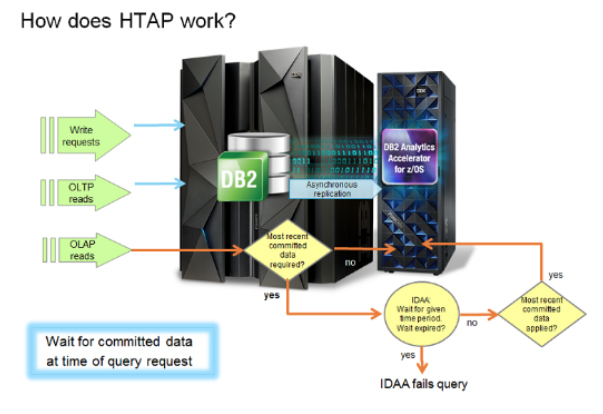Db2 for zOS is the foundation for transactional systems designed to support very high volume, high availability, security and encryption of data. Performance, reliability and throughput are essential key attributes of an industrial-strength database system.
Conversely, analytics environments typically require relatively low volume transactions, but with higher capacity requirements per transaction. Historically, supporting the high performance and high availability for analytics workloads would take specialized data structures, specialized hardware and Extract, Transform and Load (ETL) processes to construct and maintain that environment. This ecosystem, and its processes, frequently created significant concerns over data currency, data accuracy, and timeliness of data.
Db2 for zOS has, at its core, leveraged the Optimizer as key to performance for transactional systems. The Db2 Optimizer has always been used to analyze incoming queries, identify the fastest execution path, and invoke that execution path for optimal results. Often, DBAs would leverage various system attributes (EXPLAINs) to identify areas where additional database INDEXes or VIEWs may enhance SQL performance.
The Db2 for zOS ecosystem leverages this first-in-class optimizer technology to route incoming SQL queries. This same Optimizer technology has been tightly coupled with the IDAA (IBM Db2 Analytics Accelerator) to intelligently identify IDAA eligible queries. The query is analyzed by the Db2 Optimizer for execution and query performance, thereby enabling each query to run in its optimal environment, for maximum speed and cost optimization. End users associated with the query are unaware of invocation or execution of the query on the IDAA. From the end user perspective, the process is entirely transparent and does not require anything different or unique to obtain significant query performance. For DBAs, this can significantly reduce the need for additional VIEWs or INDEXes, thereby reducing system overhead, enhance database reorganization time and improve overall system performance.
HTAP Environment
Coined by Gartner, Hybrid Transaction/Analytical Processing (HTAP) is an emerging application architecture that breaks the wall between transaction processing and analytics.
Combining the Db2 for zOS database with an IDAA on the same System z provides for a hybrid database approach, which will support transactions and analytics on a single platform, with application transparency. Leveraging the IBM Db2 Analytics Accelerator for zOS (IDAA) enables HTAP by dramatically simplifying both the operational and analytics infrastructure, and significantly reducing the complexity and cost, while driving faster innovation and business agility.
This HTAP environment allows:
- Customers to leverage the sensitive, high-value data that is originating on System z for analytics
- Provides support for transactional and analytics-enabled workloads simultaneously, in a highly efficient manner
- Delivery of real-time business-critical analytics on operational data, without impacting the performance of existing mission-critical transactional systems
- Scaling to meet the needs of the organization, while delivering outstanding performance
- Infrastructures are simplified, reducing cost, resource requirements and DBA oversite
- Data latency dramatically reduced or eliminated
- Uniform policies and procedures for data access and data security
- Ability to consolidate (or remove) some of the data layers, potentially leading to a single database
HTAP Implementation
The HTAP implementation leverages the asynchronous data replication facility that is part of the IDAA v7 software. Asynchronous replication is, by default, in a continuous mode for Db2 to Accelerator data replication. To fully exploit HTAP, the DBA should pay close attention to a new parameter QUERY_ACCEL_WAITFORDATA. This specific parameter determines the number of seconds to wait (or not wait) for execution of a query on the IDAA.
Options for this WAIT are:
- Execute the query without waiting for Db2 changes to be replicated to the Accelerator.
- Allow for the most recently committed changes (on Db2) to be applied via the asynchronous replication system, and then allow them to execute the analytics query.
- Fail the query if the WAIT time has been exceeded and replication has not completed.
- Execute the query on Db2 (not the Accelerator) if a Fallback is indicated.
Summary
Real-time analytics (HTAP) will drive future business requirements and decision making. What started out as a basic appliance has grown into a powerful analytics-enablement technology, dramatically shifting the boundaries of traditional data warehouse-oriented approaches to a real-time, Hybrid Transaction and Analytics Process (HTAP).
Please contact your Mainline Account Executive directly, or click here to contact us with any questions.
More Information
Webinar-Replay-IBM-DB2-Analytics-Accelerator-zOS
IDAA and Analytics – Changing the Face of z Systems
IBM Z Leverages IFLs and Secure Service Container (SSC) for Analytics Platform
Real-Time Business Decisions with IBM Db2 Analytics Accelerator



